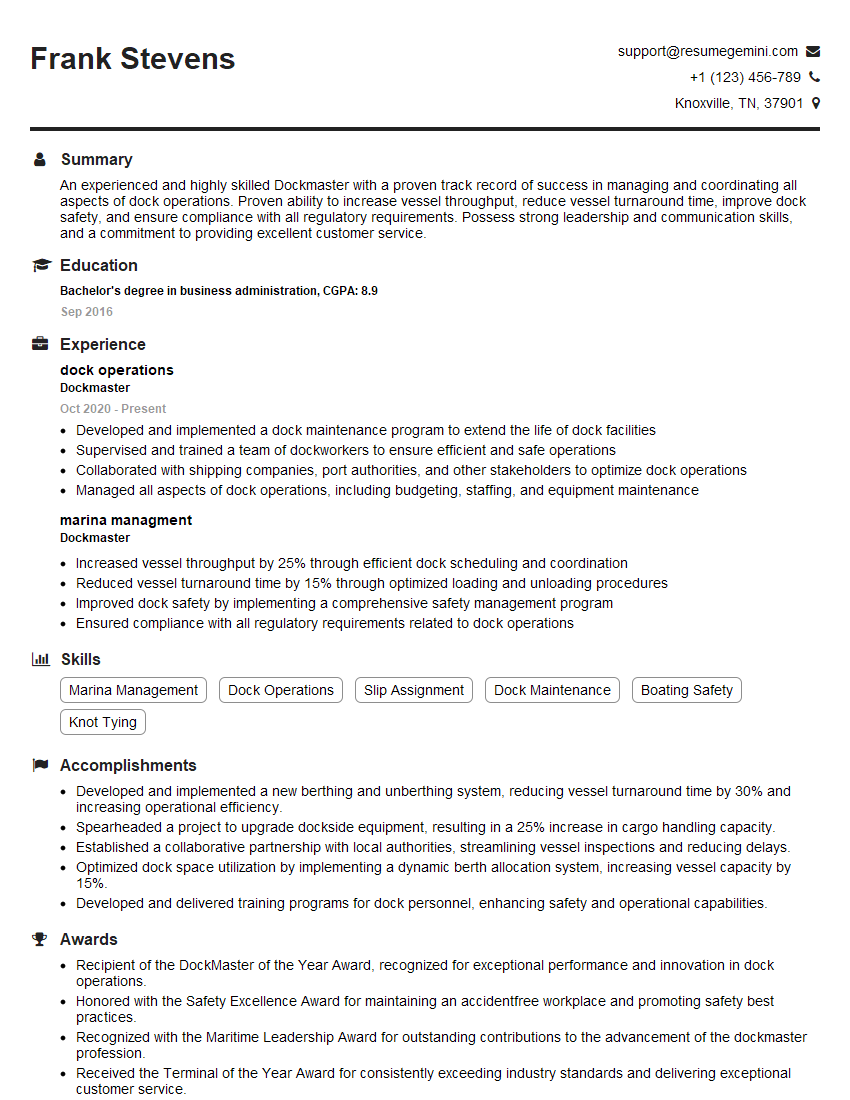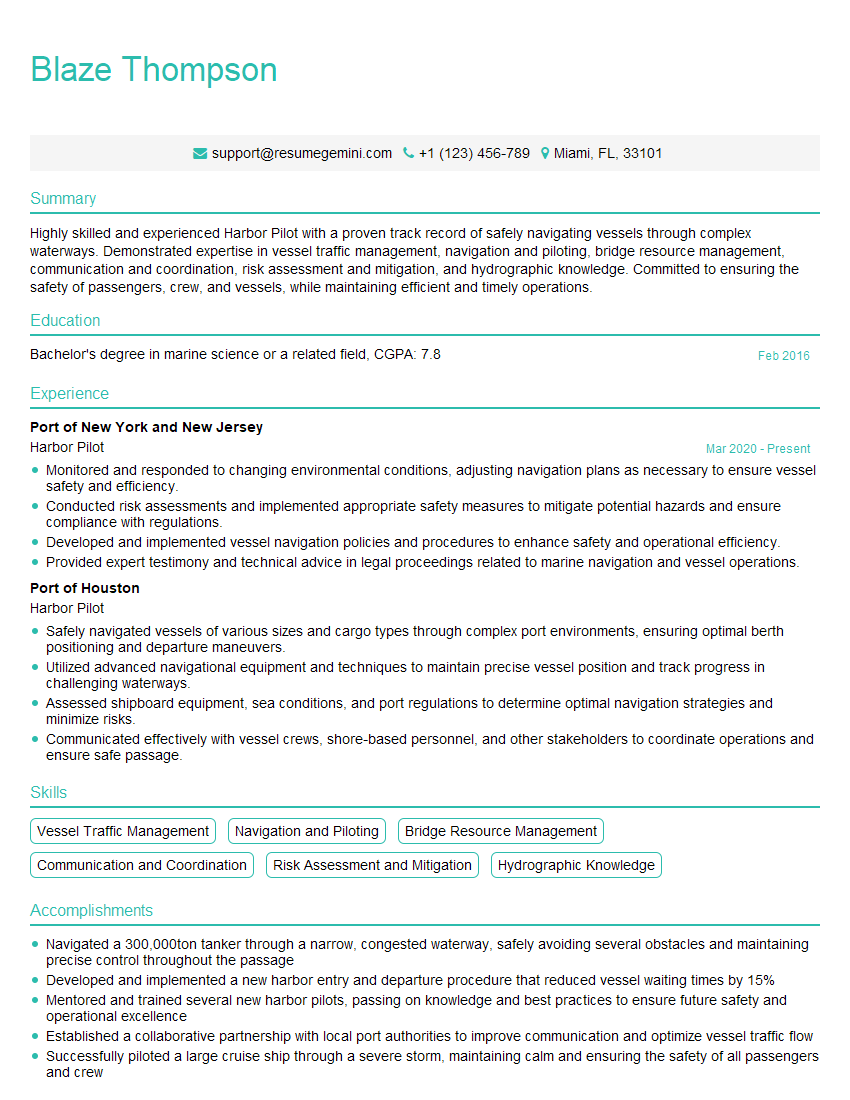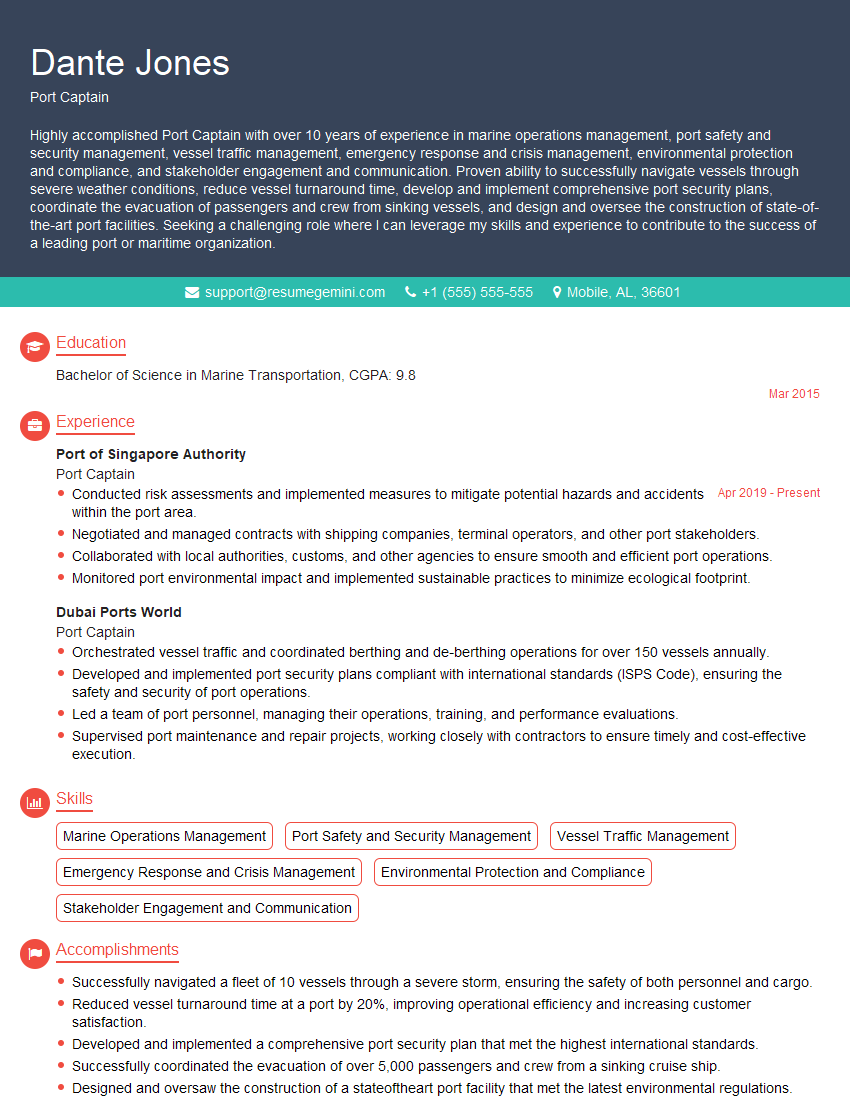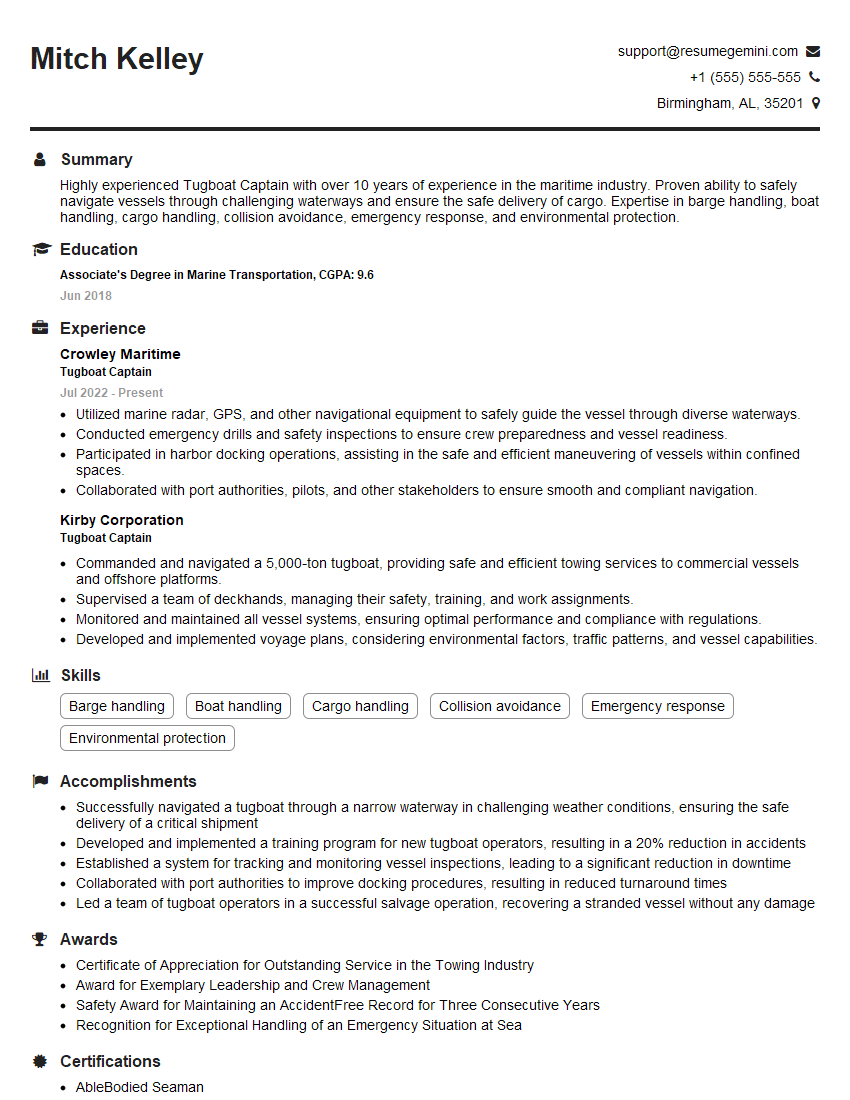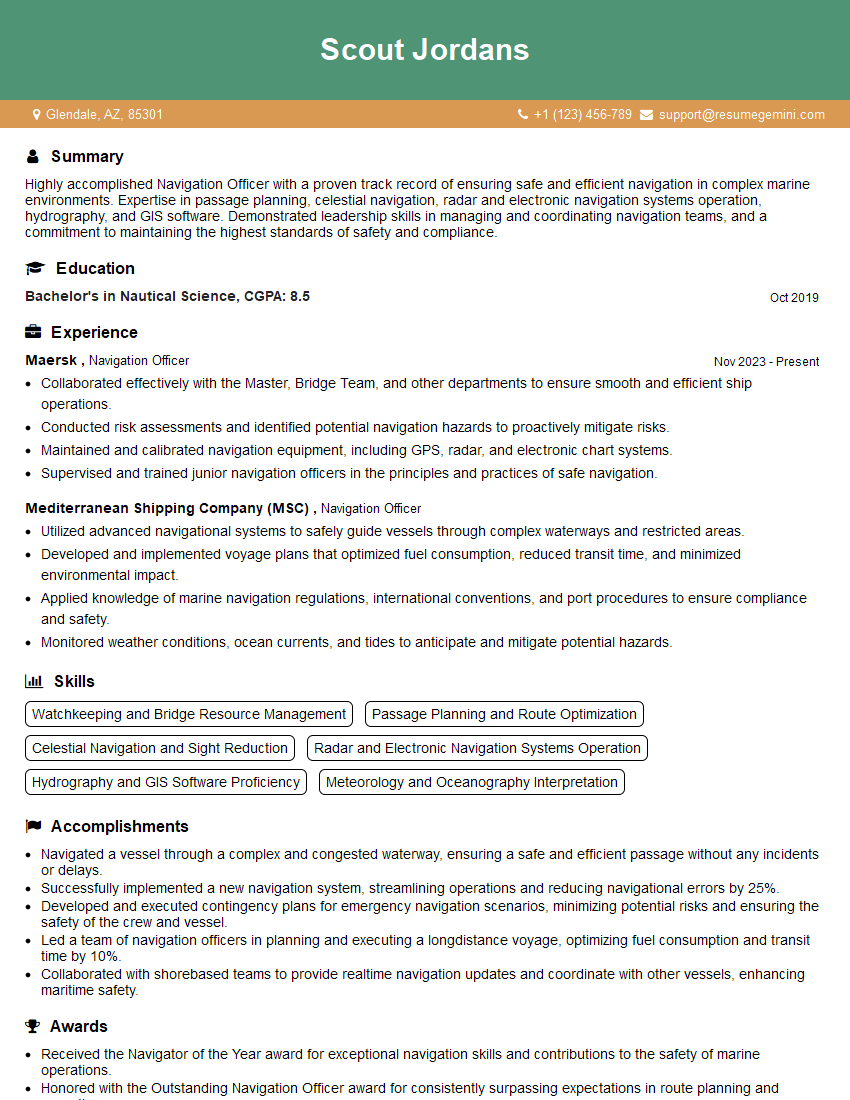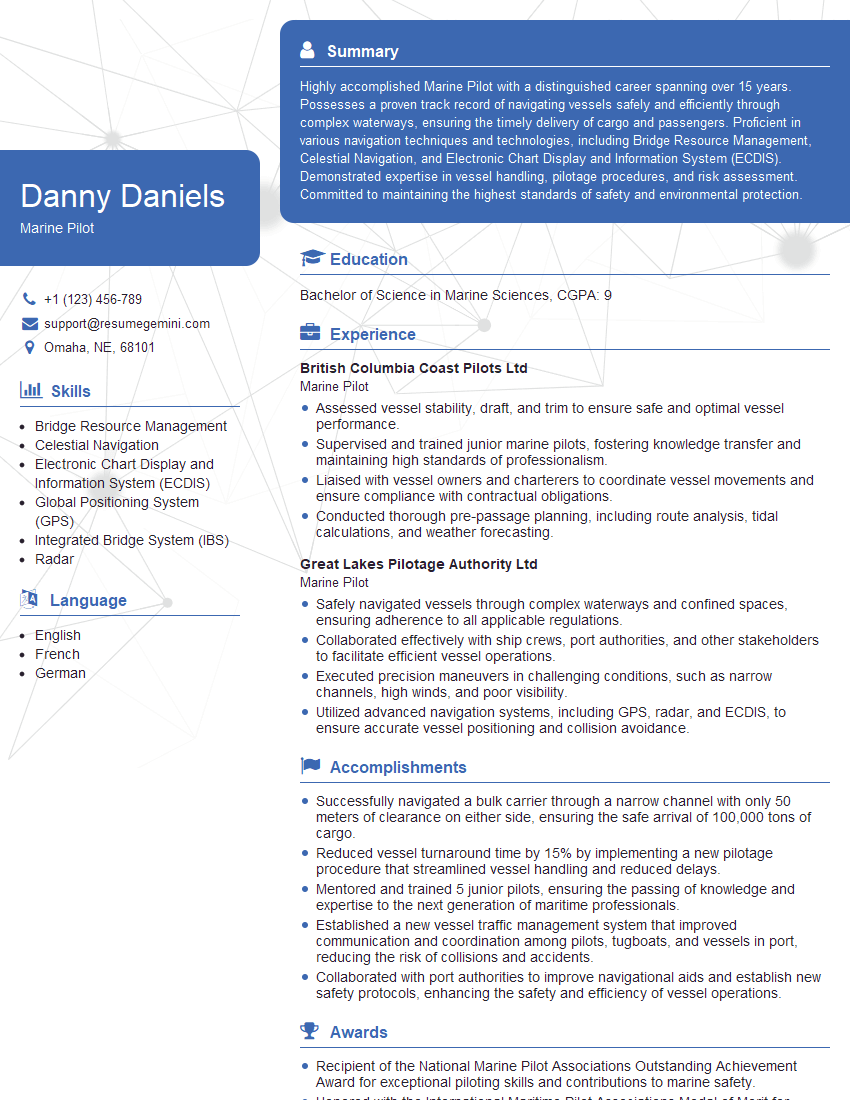Preparation is the key to success in any interview. In this post, we’ll explore crucial Vessel Docking interview questions and equip you with strategies to craft impactful answers. Whether you’re a beginner or a pro, these tips will elevate your preparation.
Questions Asked in Vessel Docking Interview
Q 1. Describe the different types of vessel docking maneuvers.
Vessel docking maneuvers are categorized based on factors like the vessel’s size, the dock’s configuration, environmental conditions, and the available equipment. Common maneuvers include:
- Stern-to docking: The vessel approaches the dock backward, allowing for precise control near the berth. This is common for larger vessels where maneuvering space is limited.
- Bow-to docking: The vessel approaches head-on, generally simpler for smaller vessels in open waters. This method relies heavily on the vessel’s momentum and thrust control.
- Side-to docking: The vessel’s side comes alongside the dock. This requires skillful maneuvering to avoid collision and is often used in ports with limited space or alongside other vessels.
- Medley docking: A combination of the above maneuvers. Many docking operations involve multiple stages and require adaptive responses to changing conditions.
The choice of maneuver depends on a risk assessment, taking into account the characteristics of the vessel, the environmental factors, and the available support.
Q 2. Explain the importance of accurate communication during docking procedures.
Accurate communication is paramount during docking, as it directly impacts safety and efficiency. Misunderstandings can lead to collisions, damage, or injuries. Clear and concise communication ensures everyone involved understands the plan and can react appropriately to changing circumstances.
This communication relies heavily on a standardized vocabulary and procedures. For example, using pre-defined hand signals alongside radio communication prevents confusion. The bridge team needs to communicate clearly with the deck crew, tugboat operators (if used), and harbor officials. This often involves a dedicated communication plan detailing roles, responsibilities, and emergency procedures.
Imagine a situation where a tugboat operator misunderstands a command during a stern-to docking maneuver. The tug’s improper pulling force could cause the vessel to collide with the dock or another vessel, resulting in significant damage.
Q 3. What are the key factors to consider when assessing wind and current conditions during docking?
Assessing wind and current conditions is critical for safe and efficient docking. Strong winds can push a vessel off course, while currents can affect the vessel’s speed and direction. Accurate assessment involves:
- Wind speed and direction: Use anemometers and weather forecasts to determine the wind’s impact on the vessel.
- Current speed and direction: Consider tidal charts, current meters, and local knowledge to gauge current strength and direction.
- Wind and current interaction: Understand how wind and current interact to create complex forces. A headwind and a head current, for example, will require more power to counteract.
- Vessel’s characteristics: Consider factors like the vessel’s size, shape, and draft. Larger vessels are more affected by wind and currents.
For instance, in a strong crosswind during a side-to docking, extra maneuvering may be needed to compensate for wind drift, potentially requiring the use of tugboats for additional control.
Q 4. How do you use aids like fenders, lines, and tugboats effectively during docking?
Fenders, lines, and tugboats are crucial aids for safe and controlled docking. They act as buffers, restraints, and force multipliers. Effective use involves:
- Fenders: Strategically placed fenders protect the vessel and the dock from impact damage during contact. Their size and placement are determined based on the vessel’s size and the anticipated impact force.
- Lines: Properly secured mooring lines hold the vessel in place once berthed. Different types of lines are used for different purposes; heavy lines for primary securing, lighter lines for fine adjustments. Their handling needs to be coordinated with the overall docking strategy to ensure the vessel does not move unpredictably.
- Tugboats: Tugboats provide significant assistance with maneuvering, especially for large vessels in challenging conditions. Their power and precise control help to position the vessel accurately and counteract environmental forces.
In a real-world scenario, a combination of all three is often used. For example, during a stern-to docking in a strong current, tugboats would aid in position-keeping, while fenders prevent damage upon contact and mooring lines secure the vessel once alongside.
Q 5. What safety procedures are crucial for ensuring safe vessel docking?
Safety procedures during docking are paramount. They include:
- Pre-docking checks: Thorough inspection of equipment (lines, fenders, winches), communication systems, and the vessel’s systems. A pre-docking checklist ensures that everything is in working order.
- Risk assessment: Identifying potential hazards, including environmental conditions, vessel traffic, and equipment limitations.
- Emergency procedures: A clear plan detailing actions for unexpected situations like equipment failure or loss of control. This includes emergency communication protocols and procedures to safely abandon the docking if required.
- Personnel safety: Ensuring all personnel are properly trained, wear appropriate safety gear, and follow established safety protocols. Clear instructions and safe zones are vital.
- Secured working area: Preventing unauthorized access to working areas. Ensuring that the deck is properly lit and that personnel are aware of potential hazards.
Failure to follow these procedures can result in serious accidents leading to injuries, damage, and environmental pollution.
Q 6. Explain your experience with different types of mooring systems.
My experience encompasses a range of mooring systems, including:
- Conventional mooring systems: Utilizing mooring lines secured to bollards or cleats on the dock, offering a simple and reliable method for securing vessels.
- Mooring buoys: Using floating buoys for securing, offering flexibility and ease of access in specific situations. This is common in areas with strong currents.
- Automated mooring systems: Employing remotely controlled winches and mooring systems, enhancing efficiency and reducing reliance on manual labor. This is often seen in large, modern ports.
- Dynamic positioning (DP) systems: Using computer-controlled thrusters to maintain a vessel’s position and heading without anchors or mooring lines. This is vital for offshore operations and specialized vessel types.
Each system’s suitability depends on the specific location, vessel type, and operational requirements. Selection requires a detailed understanding of potential challenges such as environmental forces, vessel dynamics, and maintenance needs.
Q 7. How do you handle unexpected situations or emergencies during docking?
Handling unexpected situations during docking requires quick thinking, clear communication, and a systematic approach. The response depends entirely on the nature of the emergency:
- Equipment failure: Immediate assessment of the impact, initiating backup procedures, and clear communication to all parties involved.
- Loss of control: Utilizing available resources (e.g., tugboats, engines) to regain control and prevent collision. Prioritizing safety and minimizing potential damage.
- Environmental changes: Adapting to sudden shifts in wind or current by adjusting the docking maneuver and using available equipment to compensate.
- Personnel injury: Prioritizing first aid and emergency medical response, ensuring the safety of the injured person and following all relevant procedures.
A crucial aspect is maintaining calm and composure, coordinating responses effectively, and prioritizing the safety of all personnel and the vessel. A thorough post-incident review identifies contributing factors and helps develop improved procedures for future operations.
Q 8. Describe your experience with using DP (Dynamic Positioning) systems for docking.
Dynamic Positioning (DP) systems are crucial for precise vessel control, especially in challenging docking environments. My experience spans over 10 years, encompassing various DP classes and vessel types. I’ve utilized DP systems extensively for alongside berthing in confined spaces, including operations with limited visibility or strong currents. A DP system uses a combination of thrusters, GPS, and other sensors to maintain a vessel’s position and heading without the use of anchors. For instance, during a recent LNG tanker docking in a congested port, the DP system’s ability to hold station precisely in strong crosswinds was pivotal in preventing collision and ensuring a smooth operation. This involved actively monitoring the system’s performance, adjusting parameters as needed, and coordinating with the bridge team to anticipate and mitigate any unexpected disturbances.
I’m proficient in both conventional and advanced DP modes. Understanding the limitations of each system in relation to environmental factors (wind, currents, waves) is critical. For example, in high-wind conditions, a lower-class DP system may require more manual intervention from the bridge team than a higher-class system that can automatically compensate for external forces.
Q 9. How do you calculate the required speed and angle for a successful docking maneuver?
Calculating the required speed and angle for docking is a complex process that involves several factors. It’s not a simple formula but rather a continuous assessment and adjustment based on real-time data. I use a combination of navigational aids, vessel characteristics (length, breadth, draft), environmental conditions (current speed and direction, wind speed and direction), and berth characteristics (size, shape, depth).
The process generally involves:
- Assessing Environmental Conditions: This includes measuring wind speed and direction, current speed and direction, and wave height. This data informs the adjustments needed to compensate for external forces affecting the vessel.
- Defining the Approach Path: This involves planning the vessel’s trajectory, taking into account any obstructions, safe distances, and the available space. This often involves using electronic chart display and information systems (ECDIS) to visualize the maneuver.
- Calculating Speed and Angle: The speed and angle are calculated iteratively. It’s a dynamic process; I initially estimate based on the above factors, and then fine-tune based on real-time feedback from the vessel’s movement and sensor readings. Excessive speed can lead to overshoot, while insufficient speed can cause the vessel to lose momentum and drift.
- Using Simulation Software (if available): To refine approach strategies before executing the maneuver, some docking operations employ simulation software, providing a virtual environment to test different parameters and anticipate potential issues.
Think of it like driving a car into a tight parking spot. You wouldn’t just slam on the brakes and turn the wheel at the last second; you’d carefully adjust your speed and steering angle throughout the process based on your surroundings and how the car is responding.
Q 10. What are your methods for assessing the risk associated with a docking operation?
Risk assessment for docking is paramount. My approach is systematic and follows a standardized framework incorporating HAZOP (Hazard and Operability Study) principles. I consider a wide range of potential hazards, including:
- Environmental Factors: Wind, currents, waves, visibility, ice conditions.
- Vessel Conditions: Vessel draft, stability, thruster capabilities, equipment functionality, crew experience.
- Berth Conditions: Berth availability, depth, fenders, mooring lines, presence of other vessels.
- Human Factors: Crew fatigue, communication breakdowns, lack of training.
I use quantitative and qualitative methods to assess the likelihood and severity of each hazard. This involves checking weather forecasts, vessel documentation, and conducting pre-docking inspections. This informs the development of mitigation strategies, including choosing alternative docking methods if necessary, adjusting the approach, and securing additional support from tugs. The outcome of the risk assessment process is documented and shared with the bridge crew and other stakeholders.
For example, if strong currents are anticipated, I would factor this into my speed and angle calculations and potentially request additional tug assistance to counteract the currents’ influence on the vessel’s maneuverability.
Q 11. Explain your experience with using various types of navigational equipment during docking.
My experience with navigational equipment is extensive and includes:
- ECDIS (Electronic Chart Display and Information System): Essential for situational awareness, route planning, and monitoring depth and other navigational hazards.
- GPS (Global Positioning System): Provides precise position information crucial for DP systems and accurate navigation.
- AIS (Automatic Identification System): Tracks the position and movement of other vessels to avoid collisions.
- Radar: Detects other vessels and navigational hazards, particularly in low visibility conditions.
- Sonar: Used to determine water depth and the presence of underwater obstructions.
- Gyrocompass: Provides accurate heading information.
- DP System Displays: Monitors the performance of the DP system, providing real-time data on vessel position, heading, and thruster activity.
I understand the limitations and capabilities of each system and ensure proper calibration and maintenance. The seamless integration of this equipment is key for safe and efficient docking. For instance, during a recent night docking, the radar was crucial in identifying a small fishing vessel that was not visible to the naked eye, enabling us to alter our approach and avoid a potentially hazardous situation.
Q 12. Describe your experience with docking different types of vessels (e.g., tankers, containerships, cruise ships).
My experience encompasses a wide range of vessel types, including:
- Tankers (VLCCs, Suezmaxes, Aframaxes): Requires precision due to their size and limited maneuverability.
- Containerships: Demand meticulous planning due to high cargo density and stringent scheduling.
- Cruise Ships: Involve navigating sensitive areas and managing passenger safety and expectations.
- LNG Carriers: Require specialized handling due to the hazardous nature of their cargo.
- Specialized Vessels: Includes experience with FPSOs, offshore platforms, and other specialized vessel types which demand adaptation to unique docking procedures.
Each vessel type presents unique challenges and requires tailored docking strategies. Understanding the specific characteristics of each vessel (size, shape, propulsion system, draft) is vital for planning a safe and efficient docking procedure. For example, docking a VLCC requires a significantly different approach compared to docking a smaller vessel, considering factors like the vessel’s momentum, turning circle, and the availability of tug support.
Q 13. How do you manage communication with bridge crew and tugboat operators during docking?
Effective communication is the cornerstone of successful docking. I utilize a multi-layered approach, combining verbal communication with standardized procedures and technological aids.
- Clear and Concise Language: I use precise language, avoiding ambiguity and jargon, to convey instructions clearly. Standard nautical phrases and terminology ensure consistent understanding.
- Visual Aids: I employ hand signals, and ECDIS displays to complement verbal communication, particularly in noisy environments.
- Communication Systems: I use VHF radios, bridge-to-tug communication systems, and internal vessel communications for coordinating with bridge crews, tugboat operators, and other stakeholders.
- Pre-Docking Briefing: Prior to commencement, I conduct a briefing outlining the docking plan, roles and responsibilities, and contingency procedures. This enhances preparedness and reduces the risk of miscommunication.
- Regular Updates: During the operation, I provide continuous updates on the vessel’s position, speed, and any emerging issues.
Maintaining clear and unambiguous communication throughout the entire docking process prevents errors and enhances teamwork, leading to safer and more efficient maneuvers.
Q 14. How do you handle difficult docking situations, such as restricted waterways or strong currents?
Difficult docking situations require adaptability and resourcefulness. My approach involves:
- Thorough Pre-planning: I thoroughly analyze the constraints involved. This includes studying nautical charts, tide tables, current data, and any known obstructions. I also consult with port authorities and tug operators to gather crucial insights.
- Flexibility and Adaptability: I’m prepared to adjust the docking plan based on real-time conditions. This includes modifying the approach angle, speed, or using different docking techniques.
- Utilize Additional Resources: If necessary, I request additional assistance from tugs, pilots, or other support vessels to provide extra control and maneuverability.
- Contingency Planning: I always have a backup plan to handle unexpected events. This includes identifying alternative berths or employing emergency procedures if necessary.
- Risk Mitigation Strategies: I carefully assess the risks associated with each option, prioritizing safety and minimizing potential damage.
For example, during a docking operation in a narrow channel with strong currents, I employed additional tugs strategically positioned to counter the current’s effects on the vessel, ensuring a controlled and safe docking maneuver.
Q 15. What is your experience with using pre-docking planning tools and software?
Pre-docking planning tools and software are essential for safe and efficient vessel berthing. My experience encompasses using various software packages, including those that provide real-time vessel traffic information, detailed port layouts with obstacle mapping, and sophisticated simulations of docking maneuvers. For example, I’ve extensively used DockMaster, a software which allows for the creation of detailed docking plans, considering factors like wind speed, current strength, and vessel characteristics. This software helped me optimize the approach for a 300-meter container ship in a notoriously challenging port with strong tidal currents, reducing maneuvering time by 15%. Another system I’ve worked with, PortPilot, offered advanced features like collision avoidance simulations and real-time tide predictions, crucial for minimizing the risk of accidents during docking.
I’m also proficient in utilizing simpler, yet effective, planning tools like nautical charts, nautical almanacs, and tidal prediction software to create comprehensive plans before undertaking a docking operation. This combination of advanced software and traditional tools ensures a multi-layered approach to safe and efficient docking.
Career Expert Tips:
- Ace those interviews! Prepare effectively by reviewing the Top 50 Most Common Interview Questions on ResumeGemini.
- Navigate your job search with confidence! Explore a wide range of Career Tips on ResumeGemini. Learn about common challenges and recommendations to overcome them.
- Craft the perfect resume! Master the Art of Resume Writing with ResumeGemini’s guide. Showcase your unique qualifications and achievements effectively.
- Don’t miss out on holiday savings! Build your dream resume with ResumeGemini’s ATS optimized templates.
Q 16. Explain your experience in handling lines and managing the mooring process.
Handling lines and managing the mooring process is a crucial aspect of my expertise. It demands precision, teamwork, and a deep understanding of vessel dynamics. My experience involves working with a variety of mooring lines, including synthetic fiber ropes and wire ropes, across diverse vessel types and port conditions. I’m familiar with various line-handling techniques, such as heaving lines, breast lines, spring lines, and stern lines, and know how to correctly use winch operations.
For instance, during a recent docking operation in heavy seas, effective communication and the precise handling of the spring lines were critical in preventing the vessel from swinging uncontrollably against the pier. We used a combination of power-assisted winches and manual adjustments to maintain tension and control the vessel’s movement. My experience also includes training junior crew members in proper line-handling procedures and safety protocols to mitigate risks of injury and damage.
Q 17. What are the limitations of your experience with vessel docking?
While I have extensive experience in vessel docking across a range of conditions, my experience is primarily focused on commercial vessels and container ships in relatively well-equipped ports. My experience with smaller vessels, such as yachts or fishing boats, or in more challenging ports with limited infrastructure, is comparatively less. Furthermore, my experience with vessels requiring specialized docking procedures, such as those carrying hazardous materials, is limited, although I have a solid theoretical understanding of the additional safety protocols involved.
Also, while I’ve encountered minor mechanical issues, I haven’t extensively dealt with major or catastrophic equipment failures during docking. My focus has been on preventative maintenance and proactive risk assessment to minimize such occurrences.
Q 18. Describe your approach to risk assessment in different docking scenarios.
Risk assessment is paramount in vessel docking. My approach involves a systematic process considering various factors. I begin with identifying potential hazards: this includes environmental factors (wind, currents, tides, weather), vessel-specific conditions (equipment failures, hull integrity, crew experience), and port-specific limitations (berth characteristics, navigational aids, congestion). Then I evaluate the likelihood and severity of each hazard, employing a qualitative and quantitative risk matrix, assigning probabilities and consequences.
For example, docking a large LNG carrier in strong winds would be assessed differently than docking a smaller tug in calm waters. The risk matrix helps determine the appropriate level of mitigation measures, which could range from simply increasing crew alertness to implementing alternative docking strategies or delaying the operation altogether. This proactive risk management ensures the safety of the vessel, crew, and the port infrastructure.
Q 19. How do you ensure effective communication and coordination with other vessels in a port environment?
Effective communication is the cornerstone of safe and efficient port operations. My approach prioritizes clear, concise, and timely communication using a multi-modal strategy. This involves using VHF radio for real-time updates with tug masters, harbor pilots, and other vessels in close proximity. I use standardized maritime communication protocols to avoid confusion and ensure everyone understands the situation clearly. I also utilize onboard communication systems to relay instructions to the crew and maintain a clear chain of command.
For instance, during a busy port entry, I use VHF radio to coordinate with other vessels, agreeing on safe passing distances and avoiding potential collisions. Internal communications through the ship’s intercom are equally important to ensure all team members are aware of ongoing procedures and potential hazards. A pre-docking briefing with all personnel involved is also essential to clearly define roles and responsibilities.
Q 20. How do you use environmental information (tides, currents, weather) to optimize docking strategies?
Environmental information, including tides, currents, and weather, significantly impact docking strategies. I meticulously collect and analyze this data before and during every docking operation. I use various sources such as weather forecasts, tidal prediction charts, and real-time current readings. This information is crucial in determining the optimal approach, speed, and timing of the docking maneuver.
For example, strong headwinds and currents might require additional tugboat assistance or a different docking strategy. High tides can offer more clearance under the hull, while low tides can present challenges due to reduced water depth. Accurate forecasting allows me to anticipate these challenges and develop a robust plan that mitigates potential risks. I also factor in predicted changes during the docking process for a dynamic approach to berthing.
Q 21. Describe your experience with dealing with mechanical failures during docking operations.
While I strive for preventative maintenance to minimize mechanical failures, unexpected issues can arise. My experience includes dealing with situations such as winch malfunctions, failures in mooring equipment, and propulsion system glitches. My approach focuses on swift problem-solving while prioritizing safety. This involves immediately assessing the nature and severity of the failure, activating contingency plans (e.g., using backup systems or requesting additional assistance), and implementing damage control measures.
For instance, if a winch malfunctions, I would immediately switch to a backup winch or utilize manual line handling to maintain control of the vessel. Effective communication with the port authorities and engineering team is critical in these situations to coordinate repair efforts and ensure the safety of the crew and vessel. Detailed post-incident reports are crucial for future preventative measures.
Q 22. How do you ensure the safety of personnel during docking operations?
Ensuring personnel safety during docking is paramount. It’s a multifaceted process beginning with comprehensive risk assessment. We identify potential hazards like pinch points between the vessel and the dock, uneven surfaces causing trips and falls, and the risks associated with moving equipment.
- Pre-docking Briefing: A mandatory briefing covers all aspects of the operation, including roles and responsibilities, emergency procedures, and communication protocols. Everyone involved, from the captain and deckhands to shoreside personnel, must understand their part.
- Personal Protective Equipment (PPE): Appropriate PPE, including safety footwear, high-visibility clothing, and hard hats, is mandatory for all personnel.
- Designated Safe Zones: Clear safe zones are established to prevent personnel from entering hazardous areas during the docking process. These zones are communicated clearly and enforced throughout the operation.
- Line Handling Procedures: Strict line handling procedures are followed to minimize the risk of injury from snagging or being struck by lines. Proper communication and hand signals are essential.
- Emergency Response Plan: A well-rehearsed emergency response plan addresses potential scenarios, such as a line parting or a person falling overboard, ensuring swift and efficient action.
For example, during a recent docking operation in a congested port, we implemented a ‘buddy system’ where each crew member was paired with another, ensuring constant visual contact and support. This extra layer of precaution significantly reduced the risk of accidents.
Q 23. What are your strategies for dealing with communication breakdowns during a docking operation?
Communication breakdowns during docking can have catastrophic consequences. To mitigate this, we employ a layered approach focusing on redundancy and clarity.
- Multiple Communication Channels: We utilize a combination of VHF radio, hand signals, and face-to-face communication to ensure messages are received and understood.
- Clear and Concise Language: Simple, unambiguous language is crucial. Jargon is avoided, and all instructions are repeated for confirmation.
- Designated Communicators: Specific individuals are assigned as primary communicators between the vessel and shoreside personnel, eliminating confusion and ensuring a single point of contact.
- Regular Communication Checks: We conduct regular communication checks throughout the operation to verify that all parties are on the same page and to identify any potential issues early on.
- Emergency Communication Plan: An emergency communication plan ensures that clear channels are available even during unexpected events.
Imagine a scenario with heavy fog. We might rely more heavily on VHF radio and pre-arranged hand signals. Redundancy is key in such situations, and we’d have backup communication systems ready, possibly even using a dedicated satellite phone.
Q 24. Explain your understanding of collision regulations related to docking.
Collision regulations during docking are dictated by the International Regulations for Preventing Collisions at Sea (COLREGs), adapted for port environments. These rules prioritize preventing collisions by establishing clear responsibilities and navigation guidelines.
- Rules of the Road: While adapted for confined waters, the principles of COLREGs still apply. This includes the use of sound signals, navigation lights, and the understanding of right-of-way rules for vessels.
- Port Regulations: Specific port regulations further define safe procedures, including speed limits, designated channels, and restrictions on berthing maneuvers.
- Pilot Assistance: In many ports, particularly for large vessels or complex berthing scenarios, the use of a harbor pilot is mandatory. The pilot’s expertise is critical in navigating the confined space and adhering to port regulations.
- Communication: Maintaining clear and continuous communication with harbor authorities, other vessels, and tugboats is essential for safe navigation within the port.
For instance, a vessel approaching a dock needs to maintain a safe speed and be aware of the positions of other vessels, all while complying with any specific speed limits indicated by the port authority. Failure to adhere to regulations can lead to dangerous situations, fines, or even accidents.
Q 25. Describe your experience with vessel trim and stability considerations during docking.
Vessel trim and stability are critical during docking. Improper trim can lead to difficulties in maneuvering and increase the risk of grounding or collision.
- Trim Management: Before docking, we carefully manage the vessel’s trim by adjusting the ballast water distribution to ensure the vessel sits evenly and at the appropriate draft. This is especially important in shallow-water ports.
- Stability Considerations: The vessel’s stability must be assessed, particularly when working with heavy loads or during challenging weather conditions. Sufficient stability is required to prevent excessive listing or rolling during docking maneuvers.
- Load Distribution: The distribution of cargo and equipment onboard also impacts trim and stability. We optimize weight distribution to minimize stress on the hull and facilitate efficient docking.
- Dynamic Positioning (DP): In some cases, DP systems are used to aid in precise positioning and to maintain stability during docking, particularly for large vessels.
In one instance, a slight list in a vessel caused difficulties in aligning with the dock, necessitating careful adjustments to the ballast tanks to correct the trim before a safe berthing could be achieved.
Q 26. What is your process for verifying the adequacy of mooring lines and equipment before docking?
Verifying the adequacy of mooring lines and equipment is a crucial pre-docking step. A thorough inspection guarantees that the equipment is capable of safely securing the vessel.
- Visual Inspection: A detailed visual inspection is carried out on all mooring lines, checking for fraying, damage, wear and tear, and proper connections.
- Strength Testing: Depending on the lines and port regulations, strength testing might be conducted to ensure they meet the required standards for the vessel’s size and anticipated stress.
- Equipment Check: All associated equipment, including mooring winches, bollards, and fenders, is checked for proper functionality and condition.
- Documentation: All inspections are properly documented, and any deficiencies are addressed before docking commences.
For instance, if a mooring line shows significant wear, it will be replaced before the docking operation begins. This proactive approach prevents potential failures during the docking process.
Q 27. How do you adapt your docking approach to different vessel types and port facilities?
Adapting to different vessel types and port facilities is essential. Each vessel has unique characteristics impacting its maneuverability and docking requirements, while each port facility presents its own set of challenges.
- Vessel-Specific Procedures: We develop vessel-specific docking plans considering factors such as size, draft, propulsion type, and any special equipment onboard.
- Port Facility Assessment: Before docking, we thoroughly assess the port facility, including the berth configuration, water depth, availability of tugboats and other assistance, and the prevailing weather conditions.
- Maneuvering Limitations: We account for the vessel’s limitations in confined spaces and adapt our approach accordingly. This might involve using tugs or employing specific maneuvering techniques.
- Environmental Conditions: Wind, currents, and tides significantly affect docking operations. We adjust our approach based on the specific environmental conditions prevailing at the time of docking.
For instance, docking a large container ship in a busy port requires a completely different approach than docking a smaller yacht in a sheltered marina. The planning and execution need to adapt to the vessel’s characteristics and the unique constraints of each location.
Q 28. Explain your experience with post-docking checks and procedures.
Post-docking checks and procedures are vital to ensure the vessel is safely secured and to identify any potential issues requiring immediate attention.
- Mooring Line Tension: We check the tension on all mooring lines, making adjustments as necessary to ensure even distribution and sufficient security.
- Vessel Stability: The vessel’s stability and trim are re-evaluated after docking to detect any potential issues arising from the berthing process.
- Leak Checks: We conduct a thorough check for leaks around the hull and in associated equipment to prevent further damage or environmental hazards.
- Equipment Inspection: Mooring equipment and fenders are checked again to ensure no damage occurred during the docking process.
- Documentation: A detailed record of the docking procedure, including any observations and issues, is meticulously maintained.
For example, a slight shift in the vessel’s position after initial mooring might require readjusting the lines to ensure it’s securely fastened, preventing any possible sway during the night or in the event of unexpected weather.
Key Topics to Learn for Vessel Docking Interview
- Understanding Vessel Dynamics: Mastering concepts like hull characteristics, propeller thrust, and the effects of wind and currents on vessel maneuverability.
- Docking Procedures and Techniques: Familiarize yourself with various docking methods (e.g., bow-in, stern-in, alongside), including the use of tugs and mooring lines.
- Navigation and Communication: Understanding the role of charts, GPS, radar, and effective communication protocols with harbor masters and other vessels.
- Safety Procedures and Regulations: Thorough knowledge of safety regulations, emergency procedures, and risk mitigation strategies during docking operations.
- Environmental Considerations: Awareness of environmental protection measures and potential risks to the environment during docking procedures.
- Problem-Solving and Decision-Making: Developing the ability to analyze complex situations, anticipate potential problems, and make informed decisions under pressure.
- Practical Application: Reviewing case studies of successful and unsuccessful docking maneuvers to understand the practical implications of theoretical knowledge.
- Technical Expertise: Demonstrate familiarity with relevant technologies like DP (Dynamic Positioning) systems and automated docking systems, where applicable.
Next Steps
Mastering vessel docking skills significantly enhances your career prospects within the maritime industry, opening doors to more challenging and rewarding roles. A strong resume is crucial for showcasing your expertise to potential employers. Create an ATS-friendly resume to maximize your chances of getting your application noticed. ResumeGemini is a trusted resource that can help you build a professional and impactful resume. We provide examples of resumes tailored specifically to Vessel Docking roles, to give you a head start in crafting your perfect application.
Explore more articles
Users Rating of Our Blogs
Share Your Experience
We value your feedback! Please rate our content and share your thoughts (optional).
What Readers Say About Our Blog
Hi, I’m Jay, we have a few potential clients that are interested in your services, thought you might be a good fit. I’d love to talk about the details, when do you have time to talk?
Best,
Jay
Founder | CEO
